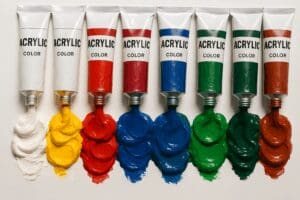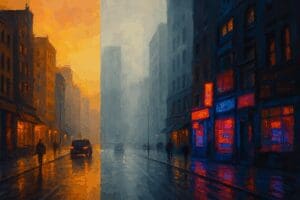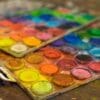Introduction:
Within the expansive canvas of art, color stands as a silent yet potent force, weaving emotions, memories, and meaning into the very fabric of a masterpiece. In this deep dive into the influence of color theory in painting, we embark on a journey to uncover the psychological and emotional effects of different colors, revealing how artists harness this knowledge to imbue their works with profound narratives.
Understanding Color Theory:
Color theory serves as the cornerstone that guides artists in harmoniously combining colors to create visually captivating and emotionally charged compositions. The primary trio of red, blue, and yellow lays the foundation for an array of color schemes – complementary, analogous, and triadic – each strategically employed by artists for achieving balance, contrast, and harmony.
The Psychology of Colors:
1. **Red: A Symphony of Passion and Energy**
– Red, with its commanding presence, evokes strong emotions ranging from fiery passion to intense anger. Dive into the psychology behind this vibrant hue.
– Link to Color Psychology: Red
2. **Blue: Tranquility’s Palette and the Depths of Emotion**
– Embracing a sense of calmness and serenity, blue is a versatile color often utilized by artists to convey depth, distance, and introspection.
– Link to Color Psychology: Blue
3. **Yellow: Radiance, Optimism, and Warmth**
– Radiating positivity and warmth, yellow adds vibrancy to artistic compositions, symbolizing optimism and joy. Uncover the psychological impact behind this sunny hue.
– Link to Color Psychology: Yellow
4. **Green: Nature’s Harmony and Symbol of Growth**
– A symbol of harmony and balance, green is often employed by artists to forge connections with the natural world. Discover the psychological nuances behind this verdant hue.
– Link to Color Psychology: Green
5. **Purple: Regality and Enigmatic Allure**
– Rich in regal associations and an air of mystery, purple finds its place in art as a color of elegance and intrigue. Explore the psychological dimensions of this captivating hue.
– Link to Color Psychology: Purple
The Artistic Application:
Acknowledging the psychological impact of colors is just the beginning; artists intricately apply this knowledge to communicate specific meanings and evoke emotions within their paintings.
1. **Vincent van Gogh’s “Starry Night”**
– A masterful display of deep blues and swirling yellows, “Starry Night” by Van Gogh invites us into a cosmic wonderland. Uncover the emotional turbulence within this iconic masterpiece.
– Link to “Starry Night” Analysis
2. **Pablo Picasso’s Blue Period**
– Picasso’s Blue Period, marked by predominantly blue tones, provides a window into the artist’s emotional struggles and melancholy. Explore the psychological depth of this transformative period.
– Link to Picasso’s Blue Period
Conclusion:
In the tapestry of painting, color emerges as a silent narrator, whispering stories of emotion, history, and symbolism. Armed with the wisdom of color theory, artists craft visual symphonies that resonate with viewers on a profound level, inviting us to explore the intricate dance between color and emotion that unfolds beyond the canvas. As we navigate this immersive landscape, a deeper appreciation for the artistry emerges, transcending the strokes of a brush into a language that speaks directly to the soul.
*For collaborations, art features, or inquiries, please contact us at in**@**********rt.ie. Don’t forget to follow us on Instagram, Facebook, Twitter.
Disclaimer: The views and opinions expressed in this article do not necessarily reflect the official policy or position of Irish Artmart.





